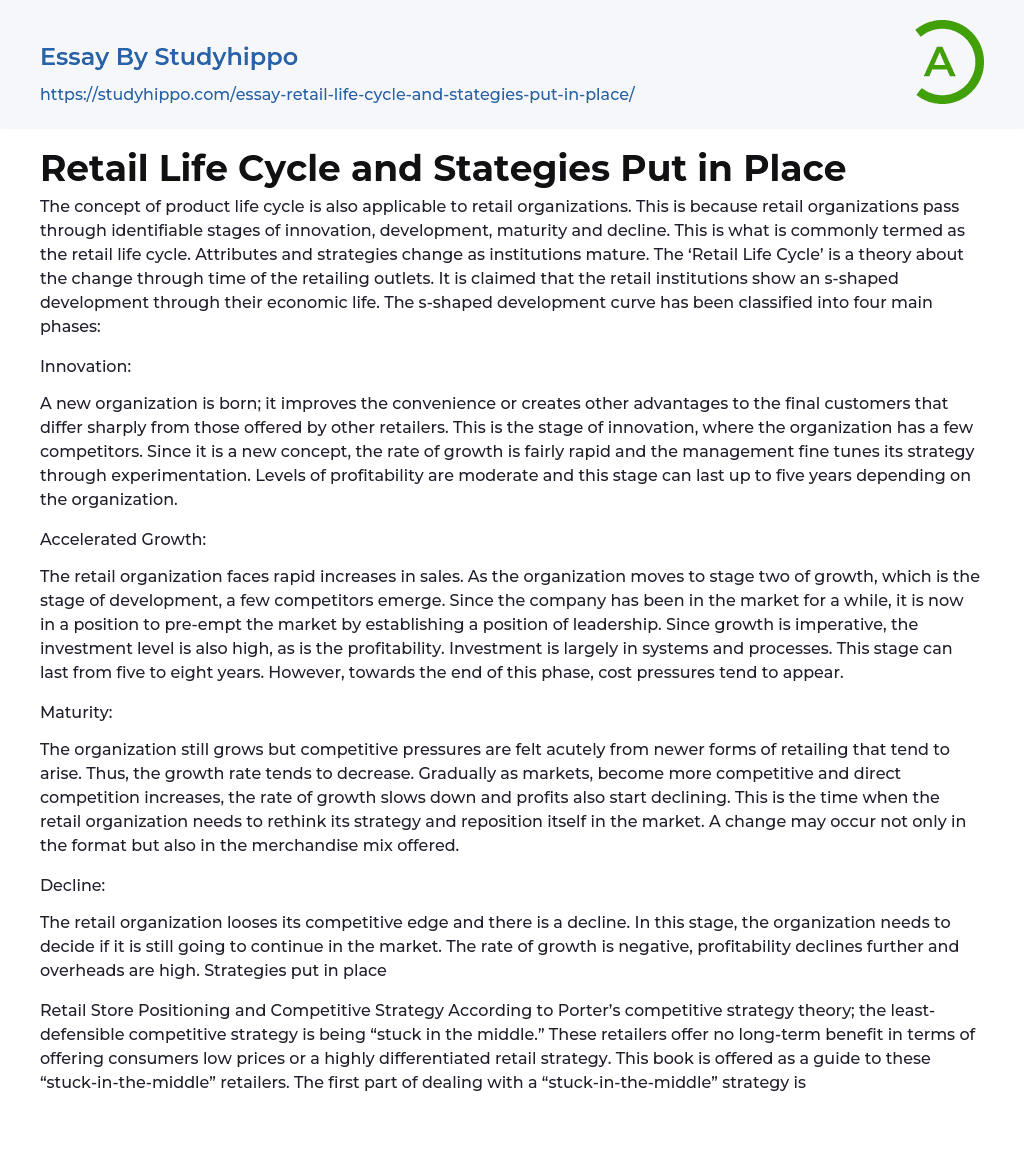

Retail Life Cycle and Stategies Put in Place Essay Example
The concept of product life cycle is also applicable to retail organizations. This is because retail organizations pass through identifiable stages of innovation, development, maturity and decline. This is what is commonly termed as the retail life cycle. Attributes and strategies change as institutions mature. The ‘Retail Life Cycle’ is a theory about the change through time of the retailing outlets. It is claimed that the retail institutions show an s-shaped development through their economic life. The s-shaped development curve has been classified into four main phases:
Innovation:
A new organization is born; it improves the convenience or creates other advantages to the final customers that differ sharply from those offered by other retailers. This is the stage of innovation, where the organization has a few competitors. Since it is a new co
...ncept, the rate of growth is fairly rapid and the management fine tunes its strategy through experimentation. Levels of profitability are moderate and this stage can last up to five years depending on the organization.
Accelerated Growth:
The retail organization faces rapid increases in sales. As the organization moves to stage two of growth, which is the stage of development, a few competitors emerge. Since the company has been in the market for a while, it is now in a position to pre-empt the market by establishing a position of leadership. Since growth is imperative, the investment level is also high, as is the profitability. Investment is largely in systems and processes. This stage can last from five to eight years. However, towards the end of this phase, cost pressures tend to appear.
Maturity:
The
organization still grows but competitive pressures are felt acutely from newer forms of retailing that tend to arise. Thus, the growth rate tends to decrease. Gradually as markets, become more competitive and direct competition increases, the rate of growth slows down and profits also start declining. This is the time when the retail organization needs to rethink its strategy and reposition itself in the market. A change may occur not only in the format but also in the merchandise mix offered.
Decline:
The retail organization looses its competitive edge and there is a decline. In this stage, the organization needs to decide if it is still going to continue in the market. The rate of growth is negative, profitability declines further and overheads are high. Strategies put in place
Retail Store Positioning and Competitive Strategy According to Porter’s competitive strategy theory; the least-defensible competitive strategy is being “stuck in the middle.” These retailers offer no long-term benefit in terms of offering consumers low prices or a highly differentiated retail strategy. This book is offered as a guide to these “stuck-in-the-middle” retailers. The first part of dealing with a “stuck-in-the-middle” strategy is a retailer’s recognizing its true positioning in the marketplace. Obviously, what is crucial is the customer’s positioning of the retailer, not the retailer’s idealized positioning. The second part of the change process is for the retailer to formulate short- and long-term plans to implement the recommended changes Michael Porter’s competitive strategy theory argues that there are two major long-term competitively defensible strategies that retailers can pursue: (1) low cost and
Low-cost retailers such as Aldi and Costco have succeeded by
reducing product choice (this translates into savings due to faster inventory turnover, lower rental costs, and greater bargaining power with individual suppliers), use of a self-service shopping environment, and an absence of services that their consumers view as secondary in importance (such as home delivery, custom cutting of meats, no try-on rooms, and an absence of in-store displays), as well as through low rental costs (due to their ability to generate store traffic). Amazom.com is also a low-cost retailer due to its ability to minimize its inventory investment through drop shipping, the absence of physical stores, and the use of consumer ratings by shoppers and excellent photographic images that can be used by consumers as a substitute for sales assistance.
At the other end of the positioning spectrum are retailers such as L.L.Bean, Nordstrom, Trader Joe’s, Wegmans, and Whole Foods. These retailers have succeeded through a differentiation strategy that combines high levels of sales assistance by a dedicated and trained staff, specialized merchandise (much of it being private label), and a shopping environment that is viewed by many consumers as exciting, entertaining, and fun.
- Advertisement essays
- Advertising essays
- Anheuser-busch essays
- Audience Theory essays
- Brand essays
- Brands essays
- Competitor Analysis essays
- Consumer essays
- Detergent essays
- Marketing Management essays
- Marketing Mix essays
- Marketing Plan essays
- Marketing Research essays
- Marketing Strategy essays
- New Product Development essays
- Point Of Sale essays
- Price essays
- Procurement essays
- Product essays
- Product Differentiation essays
- Product Placement essays
- Promotion essays
- Promotion And Marketing Communications essays
- Research Design essays
- Retailing essays
- Trademark essays
- Absolutism essays
- Appeal essays
- Bourgeoisie essays
- Contras essays
- Corporate Governance essays
- Corruption essays
- Democracy essays
- Democratic Party essays
- Developed Country essays
- Dictatorship essays
- Elections essays
- European Union essays
- Federalism essays
- Foreign essays
- Foreign policy essays
- Gentrification essays
- Hillary Clinton essays
- Income Tax essays
- International Relations essays
- John Marshall essays
- John Stuart Mill essays
- Left-Wing Politics essays
- Liberty essays
- Military essays



